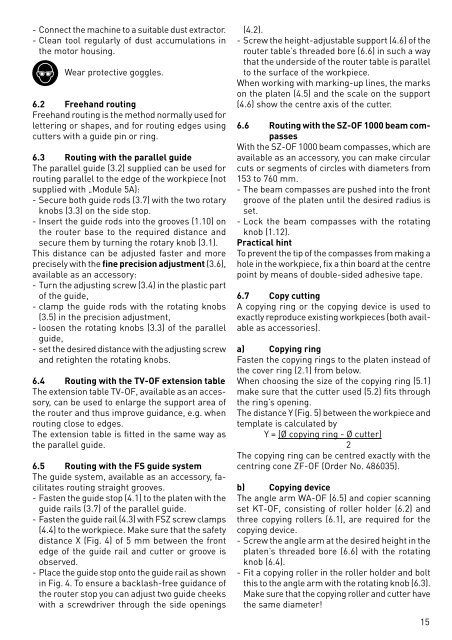Create successful ePaper yourself
Turn your PDF publications into a flip-book with our unique Google optimized e-Paper software.
- Connect the machine to a suitable dust extractor.<br />
- Clean tool regularly of dust accumulations in<br />
the motor housing.<br />
Wear protective goggles.<br />
6.2 Freehand routing<br />
Freehand routing is the method normally used for<br />
lettering or shapes, and for routing edges using<br />
cutters with a guide pin or ring.<br />
6.3 Routing with the parallel guide<br />
The parallel guide (3.2) supplied can be used for<br />
routing parallel to the edge of the workpiece (not<br />
supplied with „Module 5A):<br />
- Secure both guide rods (3.7) with the two rotary<br />
knobs (3.3) on the side stop.<br />
- Insert the guide rods into the grooves (1.10) on<br />
the router base to the required distance and<br />
secure them by turning the rotary knob (3.1).<br />
This distance can be adjusted faster and more<br />
precisely with the fi ne precision adjustment (3.6),<br />
available as an accessory:<br />
- Turn the adjusting screw (3.4) in the plastic part<br />
of the guide,<br />
- clamp the guide rods with the rotating knobs<br />
(3.5) in the precision adjustment,<br />
- loosen the rotating knobs (3.3) of the parallel<br />
guide,<br />
- set the desired distance with the adjusting screw<br />
and retighten the rotating knobs.<br />
6.4 Routing with the TV-<strong>OF</strong> extension table<br />
The extension table TV-<strong>OF</strong>, available as an accessory,<br />
can be used to enlarge the support area of<br />
the router and thus improve guidance, e.g. when<br />
routing close to edges.<br />
The extension table is fi tted in the same way as<br />
the parallel guide.<br />
6.5 Routing with the FS guide system<br />
The guide system, available as an accessory, facilitates<br />
routing straight grooves.<br />
- Fasten the guide stop (4.1) to the platen with the<br />
guide rails (3.7) of the parallel guide.<br />
- Fasten the guide rail (4.3) with FSZ screw clamps<br />
(4.4) to the workpiece. Make sure that the safety<br />
distance X (Fig. 4) of 5 mm between the front<br />
edge of the guide rail and cutter or groove is<br />
observed.<br />
- Place the guide stop onto the guide rail as shown<br />
in Fig. 4. To ensure a backlash-free guidance of<br />
the router stop you can adjust two guide cheeks<br />
with a screwdriver through the side openings<br />
(4.2).<br />
- Screw the height-adjustable support (4.6) of the<br />
router table’s threaded bore (6.6) in such a way<br />
that the underside of the router table is parallel<br />
to the surface of the workpiece.<br />
When working with marking-up lines, the marks<br />
on the platen (4.5) and the scale on the support<br />
(4.6) show the centre axis of the cutter.<br />
6.6 Routing with the SZ-<strong>OF</strong> 1000 beam compasses<br />
With the SZ-<strong>OF</strong> 1000 beam compasses, which are<br />
available as an accessory, you can make circular<br />
cuts or segments of circles with diameters from<br />
153 to 760 mm.<br />
- The beam compasses are pushed into the front<br />
groove of the platen until the desired radius is<br />
set.<br />
- Lock the beam compasses with the rotating<br />
knob (1.12).<br />
Practical hint<br />
To prevent the tip of the compasses from making a<br />
hole in the workpiece, fi x a thin board at the centre<br />
point by means of double-sided adhesive tape.<br />
6.7 Copy cutting<br />
A copying ring or the copying device is used to<br />
exactly reproduce existing workpieces (both available<br />
as accessories).<br />
a) Copying ring<br />
Fasten the copying rings to the platen instead of<br />
the cover ring (2.1) from below.<br />
When choosing the size of the copying ring (5.1)<br />
make sure that the cutter used (5.2) fi ts through<br />
the ring’s opening.<br />
The distance Y (Fig. 5) between the workpiece and<br />
template is calculated by<br />
Y = (Ø copying ring - Ø cutter)<br />
2<br />
The copying ring can be centred exactly with the<br />
centring cone ZF-<strong>OF</strong> (Order No. 486035).<br />
b) Copying device<br />
The angle arm WA-<strong>OF</strong> (6.5) and copier scanning<br />
set KT-<strong>OF</strong>, consisting of roller holder (6.2) and<br />
three copying rollers (6.1), are required for the<br />
copying device.<br />
- Screw the angle arm at the desired height in the<br />
platen’s threaded bore (6.6) with the rotating<br />
knob (6.4).<br />
- Fit a copying roller in the roller holder and bolt<br />
this to the angle arm with the rotating knob (6.3).<br />
Make sure that the copying roller and cutter have<br />
the same diameter!<br />
15


